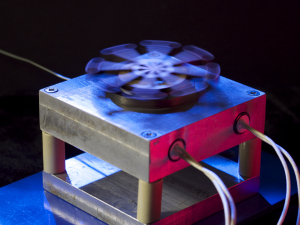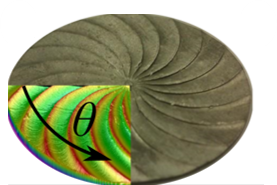Leidenfrost Engine
When a droplet of water is put on a heated surface it usually evaporates and eventually boils. However, if the surface temperature is much higher than the boiling point of water the droplet can persist for some time. This is known as the Leidenfrost effect.

We have harnessed the Leidenfrost effect to create the first example of a sublimation heat engine. Our experiments use a hot turbine-like substrate:

When a droplet of water touches the substrate, it instantly levitates on a cushion of its own vapour. The turbine-like surface shape rectifies the direction of flow and causes the droplet to rotate. This is shown in the video below.
The rotation of the droplet can be used to couple the rotation of a solid. Alternatively, a disk of solid dry ice can be placed directly onto the turbine-like surface and a thin layer of solid dry ice will directly sublimate to vapour.
Publications
- A sublimation heat engine G.G. Wells, R.L. Aguilar, G. McHale and K. Sefiane, Nature Communications 6 (2015) art. 6390. View open access version
- How energy from dry ice could power human colonies on Mars R.L. Aguilar, The Conversation online, 3rd March 2015
